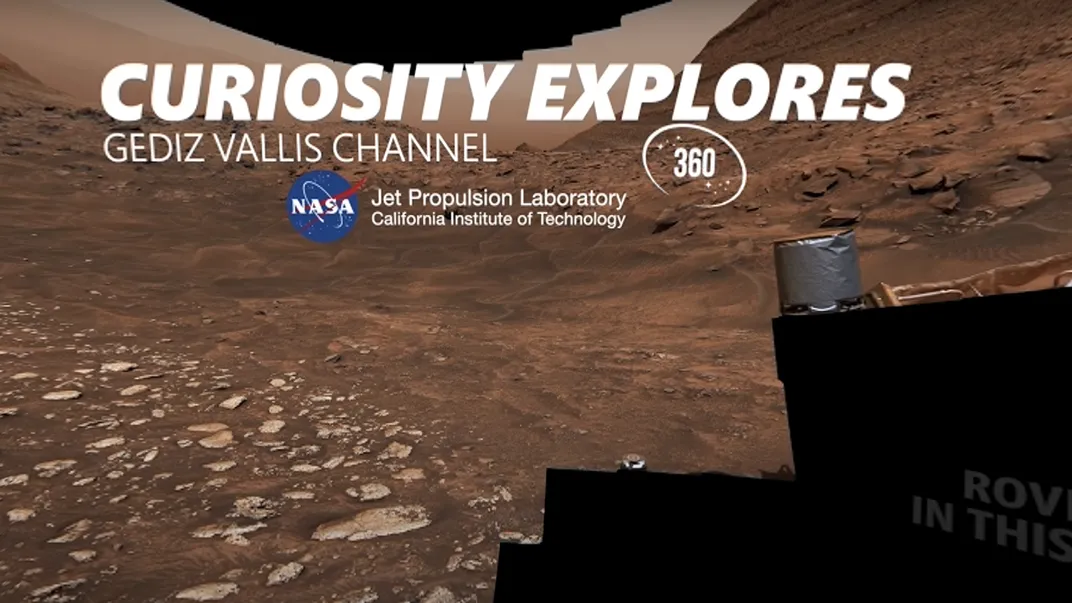NASA’s Curiosity Rover Accidentally Discovers Sulfur Crystals on Mars
The rover’s wheel cracked open a rock and revealed pure elemental sulfur, which researchers have never seen on the Red Planet before
:focal(1024x575:1025x576)/https://tf-cmsv2-smithsonianmag-media.s3.amazonaws.com/filer_public/38/bb/38bb7442-9862-40b8-89ff-a095e76d9abb/1-pia26309-curiosity-views-16x9-1.jpeg)
As NASA’s Curiosity rover rolled across the Martian terrain this spring, its wheels inadvertently cracked a rock below. The crushed material revealed yellow crystals of sulfur in its pure elemental form—a first-ever discovery on Mars.
The accidental find, which was caused by the heft of the car-sized, one-ton rover on the morning of May 30, came as a pleasant surprise to researchers. In addition to the crystals that Curiosity drove over, the rover identified a plain with similar rocks dotting the surrounding ground.
“Finding a field of stones made of pure sulfur is like finding an oasis in the desert,” says Ashwin Vasavada, lead researcher at NASA’s Jet Propulsion Laboratory, in a statement.
*Cronch* I ran over a rock and found crystals inside!
— Curiosity Rover (@MarsCuriosity) July 18, 2024
It's pure sulfur. (And no, it doesn’t smell.) Elemental sulfur is something we’ve never seen before on Mars. We don't know much about these yellow crystals yet, but my team is excited to investigate. https://t.co/Am07DuXpPX pic.twitter.com/coIqWWGGJq
Since October 2022, Curiosity has been off-roading in a “sulfate-bearing unit” of the Red Planet on a Denali-sized peak called Mount Sharp. There, the rover has discovered minerals that contain sulfur mixed with other elements—such as magnesium sulfate and calcium sulfate. These salts, which form as water evaporates, might reveal more about the presence—and disappearance—of bodies of water on Mars billions of years ago.
But the rover had not uncovered pure sulfur until now. Its latest find occurred in the Gediz Vallis channel, a groove on the side of Mount Sharp that could also contain clues to Mars’ hydraulic history, as it likely formed by flowing water and sediment. Scientists had been eager for Curiosity to explore this area.
“My jaw dropped when I saw the image of the sulfur,” Briony Horgan, a planetary science researcher at Purdue University and a member of other rover missions, tells CNN’s Ashley Strickland.
“Pure elemental sulfur is a very weird finding, because on Earth we mostly find it in places like hydrothermal vents,” Horgan adds. “Think Yellowstone! So, it’s a big mystery to me as to how this rock formed in Mt. Sharp.”
The newly discovered sulfur crystals were too delicate for the rover to drill into, but it did collect a sample of nearby bedrock for analysis.
/https://tf-cmsv2-smithsonianmag-media.s3.amazonaws.com/filer_public/99/fc/99fc9fca-f3fb-4ac8-9040-7bf2d10245a7/2-pia26308-curiosity-views-16x9-1.jpeg)
Accidental-yet-crucial discoveries by Mars rovers are not unprecedented. When the Spirit rover broke one of its six wheels in 2006, it ended up driving another half mile, all the while scraping up a white powder that researchers determined to be nearly pure silica.
/https://tf-cmsv2-smithsonianmag-media.s3.amazonaws.com/filer_public/36/2c/362cf347-fa82-4d39-a5ee-a9e06d7c6b66/1554px-pia16239_high-resolution_self-portrait_by_curiosity_rover_arm_camera.jpg)
“It showed that there were once hot springs or steam vents at the Spirit site, which could have provided favorable conditions for microbial life,” Steve Squyres, a researcher at Cornell University and the principal investigator for the Spirit rover mission, said in a statement when the rover retired in 2011.
Since landing on Mars in 2012, the Curiosity rover has climbed 2,600 feet on Mount Sharp, which lies in the center of Gale Crater—a wide, ancient lakebed—and contains layer upon layer of sedimentary rock. Because sedimentary rock tends to form at the bottom of bodies of water, not atop mountains, NASA researchers have debated whether Mount Sharp, officially known as Aeolis Mons, formed after the erosion of marine sediment or the accumulation of wind-blown sediment in the center of the crater.
Gravity measurements from Curiosity in 2019 suggested both of these ideas might be right, in part: The data revealed the surface of Mount Sharp was less dense than expected and might have accumulated both wind-blown and lake sediments at various points.
Starting in March, the rover’s investigations in the two-mile-long Gediz Vallis channel support this conclusion. It has found both rounded rocks, which seem to have been deposited by water flows, as well as angular rocks that could have come from dry avalanches.
“This was not a quiet period on Mars,” Becky Williams, a researcher with the Planetary Science Institute who uses Curiosity’s Mastcam to study the history of water on Mars, says in NASA’s statement. “There was an exciting amount of activity here. We’re looking at multiple flows down the channel, including energetic floods and boulder-rich flows.”
The accidental discovery of elemental sulfur here, which only forms in certain circumstances that scientists have not previously associated with this part of Mars, only adds to this dynamic picture of Mount Sharp.
“It shouldn’t be there, so now we have to explain it,” Vasavada says in the statement. “Discovering strange and unexpected things is what makes planetary exploration so exciting.”
/https://tf-cmsv2-smithsonianmag-media.s3.amazonaws.com/accounts/headshot/eli2.png)


/https://tf-cmsv2-smithsonianmag-media.s3.amazonaws.com/accounts/headshot/eli2.png)